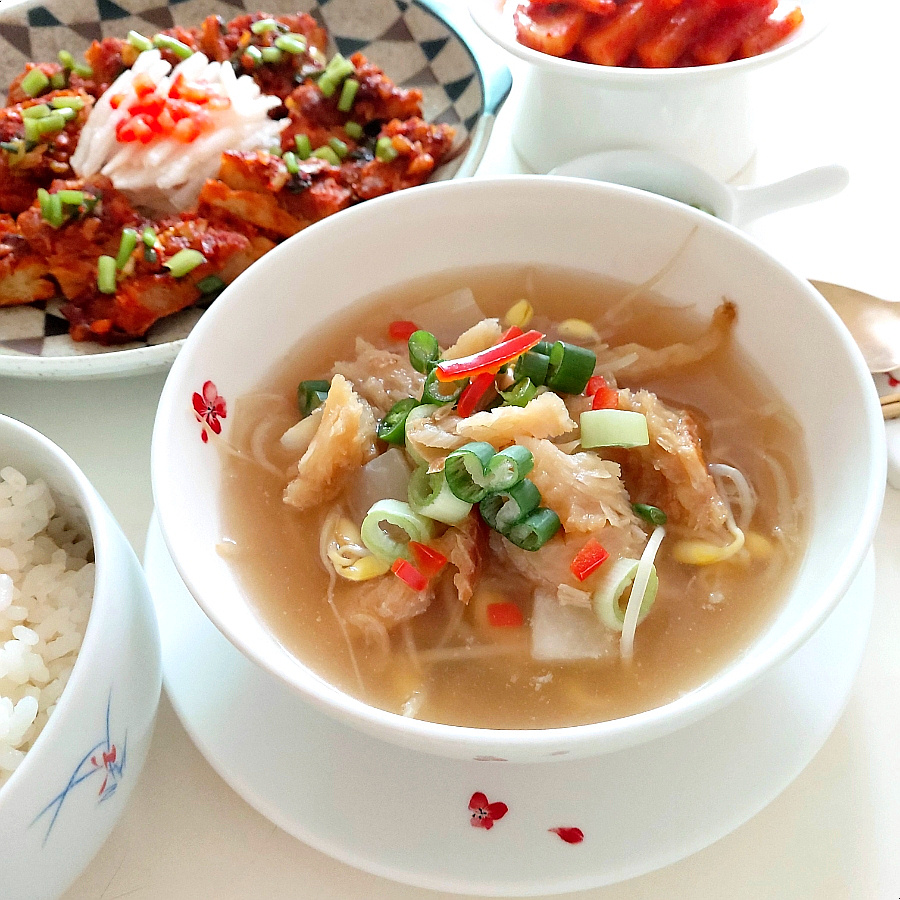Dried Pollack and Bean Sprout Soup (Hwangtae Kongnamul Guk)
The Ultimate Hangover Cure: Clear and Revitalizing Dried Pollack and Bean Sprout Soup

With the year-end holiday season bringing more gatherings and late nights, what better way to soothe your soul than with a warm bowl of Hwangtae Kongnamul Guk, the perfect remedy for a hangover or a chilly day? Imagine this: a refreshing, clear broth, perfect for spooning over rice along with some perfectly fermented radish kimchi. While some enjoy it with a swirl of beaten egg for a richer taste, today we’re focusing on a light and invigorating version that’s ideal for those days when you crave a simple, comforting broth to ease your weary stomach. This clear, rejuvenating soup, brimming with the savory essence of dried pollack and the crispness of bean sprouts, is sure to bring you comfort.
Ingredients- Dried shredded pollack (Hwangtaechae): 2 handfuls (approx. 40g)
- Bean sprouts: 1/2 bag (approx. 100g)
- Scallions (green onions): 2 stalks
- Korean radish (Muu): 1/5 of a medium radish (approx. 100g)
- Chili peppers (e.g., Cheongyang or red): 1-2
- Dried pollack and kelp broth (Hwangtae-dasima yuksu): 1/2 pot (approx. 700ml), or anchovy-kelp broth
- Rice water (Ssal-tteumul): 2-3 ladles (approx. 100ml)
- Korean soup soy sauce (Guk-ganjang): 1/2 ladle (approx. 15ml)
- Minced garlic: 1/2 tablespoon
- Salt: Pinch
- Black pepper: Pinch
- Cooking oil or olive oil: 1 tablespoon
- Sesame oil: Drizzle
- Cooking wine with ginger (Saenggang-maseul): 1/2 tablespoon (optional, to remove any fishy smell from the pollack)
Cooking Instructions
Step 1
Today, we’re sharing a basic recipe for Hwangtae Kongnamul Guk, a clear and refreshing soup made using pre-made dried pollack and kelp broth. If you prefer a richer soup, feel free to add a swirl of beaten egg or a pinch of chili powder at the end.

Step 2
1. Prepare the dried pollack: Instead of soaking the dried shredded pollack directly in water, which can cause nutrient loss, lightly dampen it by gently patting it with a wet kitchen towel or cloth. Let it sit for about 2-3 minutes until it becomes pliable. Once softened, gently knead the pollack with your hands to remove any tough bones or sharp fins. You can also trim away any tough parts with scissors for a smoother texture.

Step 3
2. Squeeze out excess water: After preparing the dried pollack, make sure to squeeze out as much excess water as possible before sautéing. Leaving too much moisture can result in a less flavorful sauté and a cloudier broth.

Step 4
3. Slice the Korean radish: Peel the radish and slice it into thin, uniform pieces about 0.3cm thick and 2-3cm long. This ‘nabak-sseolgi’ (half-moon cut) allows the radish to absorb the broth’s flavor and cook tenderly.

Step 5
4. Prepare the other vegetables: Wash the bean sprouts thoroughly under running water and drain. Finely chop or thinly slice the scallions. Slice the chili peppers (like Cheongyang or red chilies) into similar sizes. The chilies will add a pleasant spicy kick and a touch of color.

Step 6
5. Sauté the radish and dried pollack: Heat a pot over medium heat, add cooking oil or olive oil, and then add the squeezed dried pollack and sliced radish. Sauté until the radish becomes translucent and the dried pollack releases a savory aroma and turns a light golden brown. This step is crucial for developing a deep, rich flavor in the broth. * If your dried pollack has a strong fishy odor or has been stored for a long time, add 1/2 tablespoon of cooking wine with ginger at this stage and sauté together. This helps neutralize any unpleasant smells. (Keep the lid open while sautéing to allow the alcohol to evaporate.)

Step 7
6. Add broth and simmer: Once the dried pollack and radish are well sautéed and fragrant, pour in the prepared dried pollack and kelp broth until the pot is about two-thirds full. (If you don’t have this broth, anchovy-kelp broth or plain water can be used.) Bring the mixture to a boil over high heat. Tip from Romantt’s Kitchen: Adding rice water along with the broth will make the soup smoother, help mask any ‘beany’ smell from the sprouts, and enhance the clean taste. Combining broth and rice water is highly recommended.

Step 8
7. Add bean sprouts, scallions, and chilies: When the broth is boiling vigorously, add the washed bean sprouts and half of the prepared scallions and chilies. Season with Korean soup soy sauce for the first layer of flavor. Reduce the heat to medium and simmer until the bean sprouts are just tender and crisp. Be careful not to overcook them, as they can become mushy.

Step 9
8. Skim foam and adjust seasoning: As the soup simmers, impurities and any fishy residues might rise to the surface as foam. Skim this foam off with a ladle or spoon to ensure a clear broth. Taste the soup and adjust the seasoning with salt or a little soy sauce (like Ttshyu) if needed. Ttshyu can add an extra layer of umami.

Step 10
9. Garnish and serve: Once all ingredients are cooked and the seasoning is perfect, turn off the heat. Finish with a light drizzle of sesame oil. Garnish with the remaining chopped scallions and chili peppers, and a sprinkle of black pepper. Your delicious and deeply satisfying Hwangtae Kongnamul Guk is ready! Enjoy this comforting soup while it’s hot.




